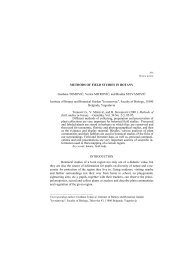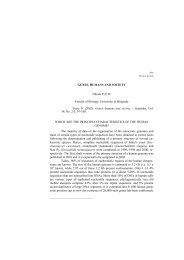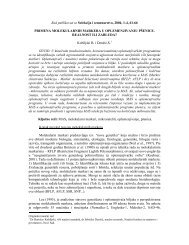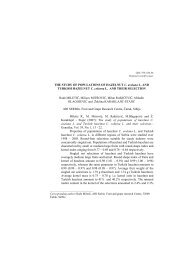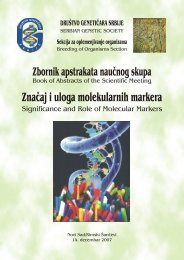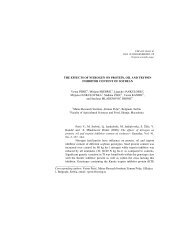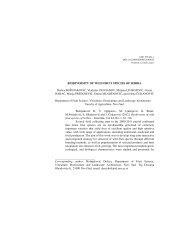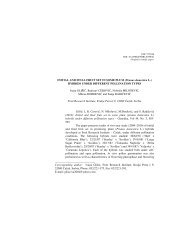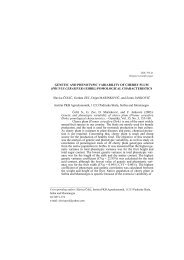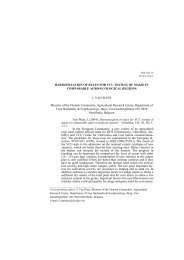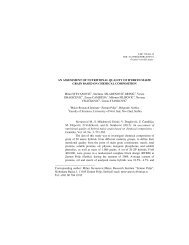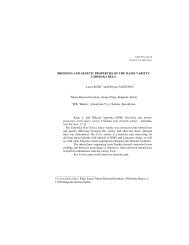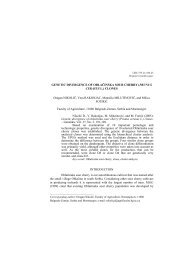Zbornik - Društvo genetičara Srbije
Zbornik - Društvo genetičara Srbije
Zbornik - Društvo genetičara Srbije
You also want an ePaper? Increase the reach of your titles
YUMPU automatically turns print PDFs into web optimized ePapers that Google loves.
226 ZBORNIK ABSTRAKATA III KONGRESA GENETIÈARA SRBIJE V-Pos-23<br />
Subotica, 30. novembar - 4. decembar 2004.<br />
KORELACIJA INFEKCIJE VISOKORIZIÈNIM HUMANIM<br />
PAPILOMA VIRUSIMA SA TOKOM BOLESTI U BOLESNIKA SA ORALNIM<br />
KARCINOMU USNE DUPLJE<br />
Z. Magiæ 1 , N. Joviæ 2 , R. Kozomara 2 i J. Stojanoviæ 1<br />
1<br />
Institut za medicinska istraivanja, Vojnomedicinska akademija, Beograd<br />
2<br />
Klinika za maksilofacijalnu hirurgiju, Vojnomedicinska akademija, Beograd<br />
Analizirano je 50 pacijenata u II i III stadijumu OSCC jezika i poda usne duplje<br />
(histološki i nuklearni gradus 1, 2 i 3). Starost pacijenata se kretala od 45 do 72 godine,<br />
97% su bili pušaèi dok je 93% konzumiralo alkohol. DNK iz tumorskog tkiva je<br />
izolovana fenol-hloroformskom ekstrakcijom. Prisustvo visokoriziènih tipova HPV (16,<br />
18, 31 i 33) je detktovano PCR-om i PAGE-om. HPV infekcija je detktovana kod 64%<br />
pacijenata. HPV16 je detektovan kod 10 pacijenata (31.2%), HPV18 i HPV31 kod 6<br />
(18.7%), dok HPV33 nije detektovan. Kod 3 pacijenta (9.3%) su detektovani<br />
istovremeno HPV16 i HPV31 a HPV18 i HPV31 kod 7 (21%). Tumori u III klinièkom<br />
stadijumu su u 58% sluèajeva sadrali neki od ispitivanih virusa. Umereno-diferentovani<br />
OSCC sa srednjim nuklearnim gradusom su najèešæe bili inficirani sa HPV (46.8%),<br />
dobro diferentovani 40.6%, a slabo-difrentovani svega 12.5%. Distribucija HPV<br />
infekcije u tumorima niskog nuklearnog gradusa (28.1%) i visokog nuklearnog gradusa<br />
(25%) je bila slièna. Pušenje i konzumacija alkohola su zavisni prediktivni faktor HPV<br />
infekcije. Period bez pojave bolesti (DFI) u ispitivanoj grupi pacijenata se kretao od 4 do<br />
36 meseci. DFI i ukupno preivljavanje (OS) kod pacijenata sa HPV infekcijom su bili<br />
znaèajno kraæi u odnosu na pacijente bez HPV infekcije (log rank test). Karcinomi usne<br />
duplje su èesto inficirani kancerogenim tipovima HPV. U ispitivanoj grupi pacijenata<br />
napena je znaèajna povezanost infekcije tumora kancerogenim tipovima HPV sa tokom i<br />
prognozom bolesti.<br />
CORRELATION OF HIGH RISK HUMAN PAPILLOMAVIRUS INFECTION<br />
WITH DISEASE PROGRESSION IN PATIENTS WITH ORAL<br />
SQUAMOCELLULAR CARCINOMA<br />
We analysed 50 patients with stage II and III of hystologically confirmed OSCC of the<br />
tonguae or oral floor (hystological and nucler grade 1, 2 or 3). Patients were 45-72 years<br />
old, 97% were heavy smokers, 93% were alcochol consumers. Genomicic DNA was isolated<br />
according to standard procedure with phenol/chloroform/isoamilalcohol. Presence<br />
of HPV types 16, 18, 31 and 33 was detected by PCR/PAGE. HPV infection was detected<br />
in 64% of patients. HPV16 was found in 10 pts (31.2%), HPV18 and HPV31 in 6<br />
(18.7%) and none with HPV33. Double positeve HPV infection HPV16+31 was detected<br />
in 3 patients (9.3%) and HPV18+31 in 7 patients (21%). Tumors in clinical stage III was<br />
more likely to contain HPV (58%). Moderately-differentiated OSCC with medium-nuclear<br />
grade were more likely to contain HPV (46.8%), well-differentiated to (40.6%) and<br />
poorly- differentiated in only (12.5%). Low-nuclear grade was detected in 28.1% and<br />
high-nuclear grade in 25% HPV positive tumors. Tobaco usage and alcochol consumption<br />
were an dependent predictor of HPV risk for OSCC. Disease-free interval (DFI) of<br />
patients ranged from 4 to 36 months. DFI and overall survival (OS) in pts with HPV infection<br />
compared to the pts without HPV infection was significantly shorter (log rank<br />
test). Infection with oncogenic HPV is frequent in oral cancers. Viral oncogene expression<br />
and viral integration suggest firm correlation between HPV infection and clinical<br />
course of disease in the examined grouop of patients.



